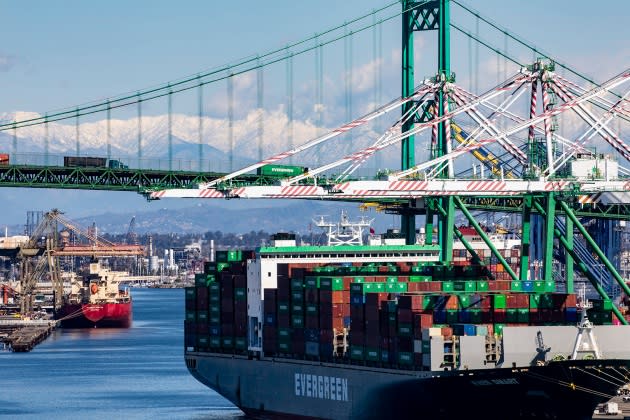Southern California Ports See Big Drop in Business

What a difference a few months make.
In July, the side-by-side ports in Long Beach and Los Angeles had one of their busiest summers ever after 25 months of non-stop record volumes.
More from WWD
Now executives at the two ports are crisscrossing the country to grab back business drifting to East and Gulf coast ports. Southern California port people are also spreading the word that the huge waterfront traffic jam that saw 109 vessels waiting for berths at the beginning of the year is over.
In November, the Port of Los Angeles and the Port of Long Beach saw precipitous reductions in cargo container volumes compared to last year. Overall, the Port of Long Beach saw a 21 percent dive in containers being unloaded and loaded. Imports were down 28.4 percent while exports were up 13.8 percent.
Next door at the Port of Los Angeles, total cargo container volume in November was off by 21 percent, with imports decreasing 24 percent compared to last year while exports were up 9 percent.
“As I’ve outlined before, an early peak season [in June and July] and a shift to other ports due to West Coast labor talks have had big impacts,” said Gene Seroka, executive director of the Port of Los Angeles, who held a virtual press conference on Wednesday to discuss cargo traffic. “Now we are seeing a nationwide slowing of imports. In fact, U.S. imports for November are expected to fall 12 percent year-over-year as retailers ease factory orders.”
For the first 11 months of this year, cargo container traffic at the Port of Los Angeles was off by 7 percent compared to the same period last year. At the Port of Long Beach, freight traffic dipped 0.5 percent.
It has been a rough two years for the ports, which had to cope with down-and-up cargo volumes affected by the COVID-19 pandemic. At first, imports plummeted because factories in China and other Asian countries were closed. Then there was a massive push to make up for lost time as U.S. consumers clambered for goods.
Imports came in so rapidly that truckers and railroad workers had a hard time clearing cargo containers from the docks. One year ago the average dwell time for a container to be picked up by a truck at the ports was 8.37 days. Now it is 3.1 days.
The ports have seen the number of long-dwelling containers reduced by 90 percent since the end of October 2021. One of the reasons is that both ports threatened to impose a $100 daily dwell fee on each container remaining on the docks for more than nine days.
Dockworkers also picked up the pace. “We appreciate the exceptional work of the dockworkers who moved containers off the docks and helped us speed the flow of cargo during an unprecedented surge over the last two years,” said Long Beach Harbor Commission President Sharon Weissman.
With cargo flows dwindling and traffic moving to other ports, Seroka of the Port of Los Angeles said he has spent the last six weeks traveling across the U.S. to talk with importers and logistics executives about keeping their business in L.A. “I am making sure they understand the truth. We have wide open capacity here in Los Angeles. Our productivity numbers look pretty good,” he said.
But many supply chain people are concerned that a labor contract between the 22,000 dockworkers at 29 West Coast ports and the 70 terminal operators who employ them has not been resolved since the agreement expired on July 1.
Negotiations continue but both sides have been silent on their progress. “I remain optimistic that these very capable negotiators are going to get an agreement together early next year,” Seroka said. “It can’t happen fast enough.”
Still, the nation’s ports will be experiencing a slow beginning next year. Not only are Chinese factories still affected by pandemic illnesses and quarantines, but Chinese New Year comes early in 2023, landing on Jan. 22.
In the past, Chinese and Asian factories have shut down for two weeks to celebrate. This year, they are expected to be closed for four to five weeks.
Jeremy Nixon, chief executive officer of Ocean Network Express, a large Asian shipping carrier, joined the press conference from his Singapore office to explain that cargo container traffic during the early part of next year will be down drastically.
“We can actually expect quite a slow February, March and April because most of the factories in China and Vietnam are going to take quite a long break,” Nixon explained. “Typically, they take two weeks off during Chinese New Year, but this year we are looking at four to five weeks. Effectively, factories will start closing around the 7th of January and probably remain closed until the 6th of February.”
The Ocean Network Express executive said his company’s sailings will be down 50 percent during the extended factory shutdown period.
